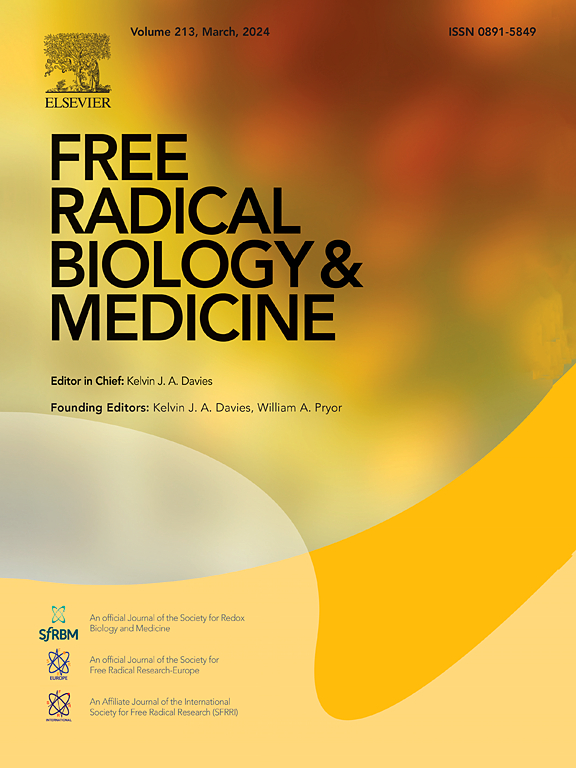An unusual semiquinone-mediated self-catalysis redox mechanism for the reaction between halohydroquinones and N-substituted hydroxamic acids
IF 7.1
2区 生物学
Q1 BIOCHEMISTRY & MOLECULAR BIOLOGY
引用次数: 0
Abstract
We found recently that a C-C bonding phenyl-quinone product was produced with high yield (96 %) from the reaction between 2,5-dichloro-1,4-benzoquinone (DCBQ) and N-phenylbenzohydroxamic acid (N-PhBHA) via an unusual Claisen rearrangement mechanism, accompanied with the concurrent formation of the minor byproducts amide (N-phenylbenzamide, N-PhBA; only 2 % yield) and hydroxychloroquinone (2 % yield). Surprisingly, when DCBQ was replaced with its reduced form 2,5-dichloro-1,4-hydroquinone (DCHQ), no C-C bonding product was detected, whereas N-PhBA (83 % yield) and hydroxychloroquinone (80 % yield) became the predominant products, indicating a dramatic mechanistic shift. The ascorbate reduction experiment suggested that it was not DCHQ itself, but its corresponding semiquinone radical, that directly reacts with N-PhBHA. Analogous results were observed when N-PhBHA was substituted with its N-methylated analog (N-methyl Benzohydroxamic acid, N-MeBHA), and when DCHQ was replaced with other halohydroquinones. Taking advantage of the relative stability of the N-MeBHA-quinone conjugate intermediate, we demonstrated that this quinone conjugate was capable of being reduced to its semiquinone form by DCHQ. Taken together, we proposed an unusual semiquinone-mediated self-catalysis redox mechanism for the reaction between halohydroquinones and N-substituted hydroxamic acids.

卤代对苯二酚与n -取代羟肟酸反应的半醌自催化氧化还原机制。
我们最近发现,2,5-二氯-1,4-苯醌(DCBQ)和n -苯基苯氧肟酸(N-PhBHA)通过一种罕见的Claisen重排机制,以高收率(96%)生成了C-C键苯醌产物,并伴有次要副产物酰胺(n -苯基苯甲酰胺,N-PhBA)的生成;仅2%产率)和羟氯醌(2%产率)。令人惊讶的是,当DCBQ被其还原形式2,5-二氯-1,4-对苯二酚(DCHQ)取代时,没有检测到C-C键产物,而N-PhBA(收率83%)和羟基氯醌(收率80%)成为主要产物,这表明了戏剧性的机制转变。抗坏血酸还原实验表明,直接与N-PhBHA发生反应的不是DCHQ本身,而是其对应的半醌自由基。当N-PhBHA被其n -甲基化类似物(n -甲基苯甲氧肟酸,N-MeBHA)取代时,DCHQ被其他卤代对苯二酚取代时,也观察到类似的结果。利用n - mebha -醌缀合中间体的相对稳定性,我们证明了该醌缀合物能够被DCHQ还原为半醌形式。综上所述,我们提出了一种罕见的半醌介导的卤代对苯二酚和n -取代羟肟酸之间反应的自催化氧化还原机制。
本文章由计算机程序翻译,如有差异,请以英文原文为准。
求助全文
约1分钟内获得全文
求助全文
来源期刊

Free Radical Biology and Medicine
医学-内分泌学与代谢
CiteScore
14.00
自引率
4.10%
发文量
850
审稿时长
22 days
期刊介绍:
Free Radical Biology and Medicine is a leading journal in the field of redox biology, which is the study of the role of reactive oxygen species (ROS) and other oxidizing agents in biological systems. The journal serves as a premier forum for publishing innovative and groundbreaking research that explores the redox biology of health and disease, covering a wide range of topics and disciplines. Free Radical Biology and Medicine also commissions Special Issues that highlight recent advances in both basic and clinical research, with a particular emphasis on the mechanisms underlying altered metabolism and redox signaling. These Special Issues aim to provide a focused platform for the latest research in the field, fostering collaboration and knowledge exchange among researchers and clinicians.
 求助内容:
求助内容: 应助结果提醒方式:
应助结果提醒方式:


